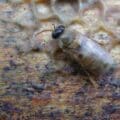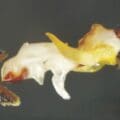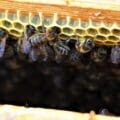Selection and reproduction
by Giacomo Acerbi
It takes a flower
Everyday things
They tell secrets
To those who know how to look at them
And listen
To make a table you need wood
To make wood you need the tree
To make the tree you need the seed
To make the seed you need the fruit
To make the fruit you need the flower
Sergio Endrigo
The poetic nursery rhyme of Gianni Rodari, set to music in the seventies by Sergio Endrigo, has proposed – now to various generations – with disarming simplicity the complexity and interconnection of the set of life cycles.
In our journey of deepening and knowledge on the phenomena that regulate and contribute to the fertility of the hive, we have stumbled upon multiple and unexpected aspects linked and synergistic. We reported the new knowledge on the life cycle of our “sperm with wings”, on the various aspects that affect its vitality, health, reproductive quality …, then we focused on its ability to fly, orient, collaborate, competition, mating … We have drawn a vision of the drone completely overturned: from a mere organism functional only to reproduction, to a fundamental link in the biology of the hive.
While the irreversible expulsion of the endophallus post mating causes the drone to fall dying to the ground, a living portion of it continues to play its part and influence the fate of the hive superorganism. But this, unusual for us humans, post-mortem influence has many implications and not a few possible repercussions, on aspects until recently marked by complete ignorance. Until recently, basic questions remained unresolved, such as: who prevails in reproductive capacity? The kelp that “donated” the most sperm? How do you arrange sperm in the spermatheca, stratified? So are there successions of patrilineal fertilizations? Our journey therefore continues in the recent and fascinating scientific acquisitions and hypotheses: how and which spermatozoa live beyond the death of the kelp; What functions related to the maximization of polyandry (1) they are activated in the fertilized queen bee; what allows the preservation of sperm in the spermatheca; the possible decision-making powers of the queen bee to fertilize its eggs.
Remember? In fertilization, 6 to 12 million sperm are transferred from the seminal vesicles of the drones into the queen’s genital orifice (Rhodes, 2011).
Greek vase (530 BC)
The man has only recently managed to keep his sperm viable over time, with cryopreservation, at cryogenic temperatures (-196 ° C). While the viability over time of spermatozoa is a natural phenomenon present in several other living species, including with considerable timing in some species of hymenoptera such as bees, leaf-cutting ants and bumblebees
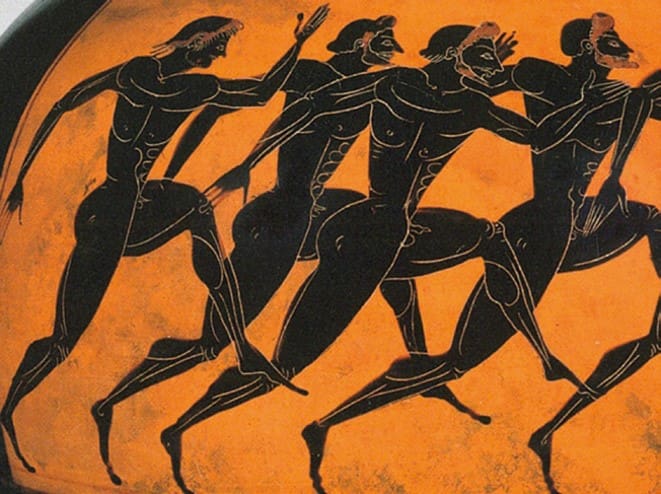

Robert Delaunay, Runners (1924)
Only 3%-5% of the spermatozoa collected in fertilizations get to be stored in the spermatheca
The expulsion of the endophallus and its rupture in the vaginal canal of the queen, makes it a temporary plug, which prevents the escape of sperm (Rhode, 2011). Then the sperm reaches the queen’s oviducts, but only an amount of about 10% of the volume of semen ejaculated by the drones (Brutscher, 2019). The next passage of sperm from the oviducts to the spermatheca lasts about 40 hours, and starts from the return to the hive from the queen’s nuptial flight.
In the end, only 3% to 5% (2 to 7 million) of the total sperm collected during fertilization is stored in the spermatheca (Koeniger, 2007), with an average ranging between 4 and 5 million (Tarpy, 2012). This amount of sperm is enough to fertilize millions of eggs (potential estimated at 1.7 million offspring) in the entire life cycle of the queen bee (Collins 2016), which determines the size, longevity and fitness limit of the colony. The future of the hive therefore depends on the quality and quantity of sperm stored in the spermatheca.
Yet another exceptional peculiarity of bees: nourishing and guaranteeing long life to sperm
Recent studies have shed light on another exceptional piece of hive fertility: the rare and distinctive ability to keep sperm viable for years, in the spermatheca. Extraordinary evolutionary and adaptive peculiarity that are able to express some species of hymenoptera (bees, bumblebees, leaf-cutting ants …): being able to keep sperm viable for long periods of time, thanks to highly specialized morphological structures for sperm preservation, known as spermatheca (Eberthard, 1985).
The queens “support” the viability over time of the stored sperm, with glandular secretions that contain proteins, metabolites, antioxidant defense enzymes etc …
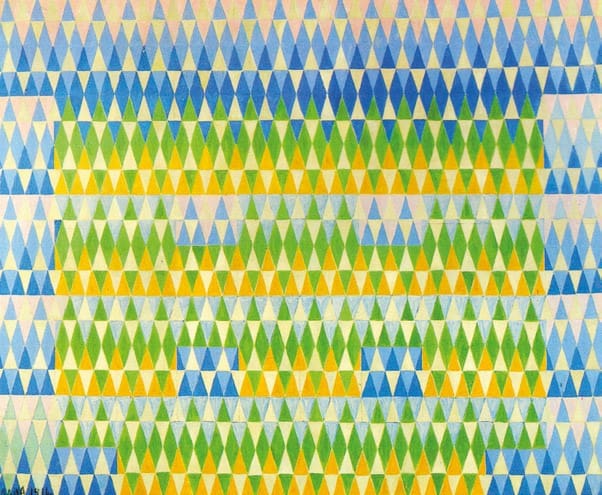
Giacomo Balla “Iridescent interpenetration number 5” Eucalyptus 1914
The queens “support” the viability over time of the stored sperm, with glandular secretions that contain proteins, metabolites, antioxidant defense enzymes etc …
Queens “support” sperm with glandular secretions produced by the spermatheca glands, and thus play a crucial role in maintaining sperm viability (Ruttner, 1971). These secretions contain proteins, metabolites, antioxidant defense enzymes and have a high pH due to sperm fluid, functional to lower the metabolic rate of sperm in storage (Klenk, 2004).
Giacomo Balla “Iridescent interpenetration number 4” Study on light, 1913
The protein structure of the spermatheca of the virgin queen bee is different from that of the fertile queen bee, with adaptations whereby the female partially imitates the environment of the seminal fluid of the kelp, and then modifies it in several successive stages
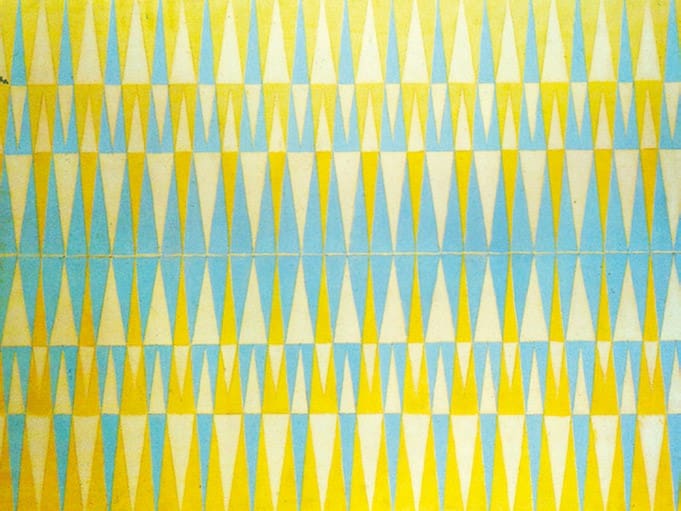
Recent studies on the characterization of the constituent components of the spermatheca and on the metabolic networks that regulate them, have begun to shed light on an aspect still largely unknown but with very important repercussions on biology, breeding and selection of Apis mellifera: the influence and ability of queen bees to manipulate stored sperm. Both the seminal fluid of the kelp and the fluid of the spermatheca of the queens have the function of nourishing, keeping the spermatozoa viable, reducing their oxidative stress, protecting them from microbial attacks. Incredibly, the composition of these two different liquids and “habitats” differs greatly: with only a 20% correspondence between the two protein sets.
François Huber, the blind beekeeper who revealed knowledge. Does vision or sight matter more?
Swiss scholar and entomologist who lived between 1750 and 1831. As a young man, around the age of 15, he began to progressively lose his sight. This did not prevent him from devoting himself to an intense activity of studies, rigorous research and innovative naturalistic observations.
Even in the early 700s it was believed that the hive was run by a king. Only in 1737 the Dutchman J. Swammerdam had ascertained the existence of the breeding apparatus of the queen bee. But at the time it was believed that queens fertilized in the hive, thanks to “aura seminalis”, fumes of the drones.
Huber was able to translate his visual impairment into a lever of strength, perhaps also for fear that his observations would be received with distrust and prevention. In team with his faithful assistant François Burnens, of humble extraction and tenacious ability and insight, he was able to develop a strictly scientific method of observation, with much more thirst to understand and demonstrate, than not to seek confirmation of his hypotheses.
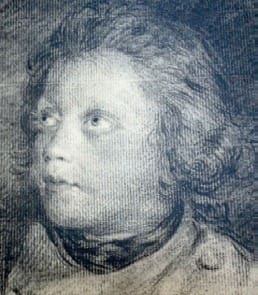
Portrait of François Huber as a child, made by his father
That is, he was able to combine the ability to question oneself with the need to corroborate hypotheses with indisputable objective assessments. Exemplary are, in fact, the methodological descriptions for the repeatability of his experiments. To his scientific observations we owe among other things: the discovery and proposal of use of the bee space, the confirmation of generation of queen bees from feeding the larva with royal jelly, the demonstration of the real mating in flight, the ascertainment of the infertility of the ovifying worker bees, the descriptions and explanations of the elimination of the drones at the end of the breeding season, the identification of the methods of production of beeswax, the identification of oxygen consumption and air movement by bees.
He knew how to strip himself of the habitual reflection and reflect human attitudes on the animal world, to strive instead to grasp the essence of the living species he investigated.
In the progressive and complex unveiling of the peculiar manifestations of the reproductive fertility of bees, we give credit to the pioneers who helped to explore paths of knowledge.
Body changes from “adolescence” to childbearing age
The protein structure of the spermatheca of the virgin queen bee is different from that of the fertile queen bee. This suggests that in order to reduce energy costs aimed at sperm storage, the evolutionary strategy of bees has determined adaptation periods in which the female partially imitates the environment of the seminal fluid of the kelp, and then modifies it in several successive phases (Baer, 2009). Therefore, physiological requirements essential for the survival and viability of sperm in bees are “outsourced” to the female component that nourishes, preserves, protects and manipulates male sperm. This is the unique nature specialization of which only some social hymenoptera are capable. What is the common thread that determines this incredible ability?
Polyandry: the heart and cornerstone of the evolutionary and survival strategy of the genus Apis. It is in fact highly probable that in a genetically complex society such as that of bees, in which the kinship relationships of the offspring are determined by the different genetic origin of the sperm used for the fertilization of the eggs, the queens influence the paternity by manipulating the sperm stored in the spermatheca (Simmons, 2001).
From these still sketchy approaches of knowledge can be glimpsed, two of the most interesting and unknown aspects of the biology of the bee, or mechanisms of sexual selection that can determine and define the patrilinearity of the colony: on the one hand the competition of sperm and on the other hand the cryptic choice of the queen.
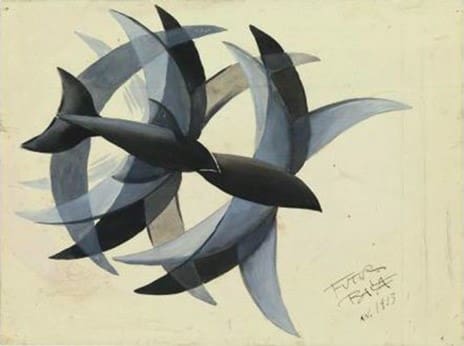
Giacomo Balla – Flight of Swallows, 1913
In the deposition the queen bee uses 4 to 12 spermatozoa for each fertilization. It is hypothesized that the most viable sperm may be the one most likely to be able to fertilize the egg
Spermatozoa: competition is competition
Following the nuptial flights, only 4.7 million of the approximately 200 million sperm stored in the Queen’s oviducts (Winston, 1991), are transferred to the spermatheca (Baer, 2004) where they are completely mixed (Laidlaw and Page, 1984).
Of these only between 1 and 1.7 million will be used to fertilize eggs in the time to come. It is hypothesized that after the mixing of the sperm, the sperm competition can take place in two different phases: both in the process of sperm preservation and especially on the occasion of use, that is, when the eggs are fertilized (Baer, 2004).
The sperm is, in fact, totally mixed as soon as the transfer process in the spermatheca is finished (Tauz, 1998).
The actual competition is therefore likely to occur in the fertilization phase, where the spermatozoa of different males meet the same egg (Baer, 2004). The queen bee uses, in fact, more than one sperm – from 4 to 12 – for each fertilization (Yu and Omholt, 1999) and it is therefore conceivable the scenario for which the most viable sperm is the one most likely to be able to fertilize the egg.
Moreover, the sperm size of bees is considerably larger than that of other non-polyandrous social insects, such as bumblebees. An aspect that can make sperm storage more complex, but that can be advantageous if the spermatozoa have to compete with other unrelated ones, of different genetic origins; there is no doubt that the longest sperm moves faster.

Johannes Vermeer, The Girl with the Turban or The Girl with the Pearl Earring, 1665
A well-founded hypothesis is that queen bees are able to “choose” and thus equalize the contribution of drones, regardless of the amount of sperm donated. A further step in the genetic strategy of “reshuffling the genotype”, for the increase of genetic diversity in the offspring
The mysterious and “cryptic” “choice” of the queen bee
The other phenomenon that can affect the fate of sperm occurs in the storage of sperm and in the phase of use of sperm, when the egg is fertilized (Simmons, 2011). The preservation of sperm in bees is a combination: on the one hand the spermatozoa actively swim along the spermatic duct, on the other hand the abdominal contractions of the queen push the sperm out of the oviducts; all functional to prevent, for example, the introduction into the spermatheca of dead or damaged spermatozoa (Ruttner and Koeniger, 1971). The hypothesis is that the queen bee may play its own choice, called cryptic (Baer, 2004), a function that could have a considerable role on the patrilinearity of a colony.
Just as the queen adjusts for the duration and frequency of nuptial flights as a function of the amount of sperm accumulated in the oviducts, it is assumed that she is able to estimate the amount of sperm transferred to the spermatheca, and its consequent filling (Woyke, 1984).
How much and how can the queen bee condition sperm according to, for example, their different genetic origin? Can a queen favor a specific male? Does it have neuronal mechanisms that allow an immediate selective advantage of this type? A plausible possibility is that, once the unwanted sperm are discarded, the queens try to equalize and equalize the contribution of the drones, regardless of the amount of “donated” sperm.
A further step in the genetic strategy of “genotype mixing” that results in an overall increase in genetic diversity in the offspring (Ratnieks, 1996), to benefit the colony’s performance. Several studies have, in fact, verified that, in the distribution of the patriline of the colonies, no one is able to monopolize the distribution in the progeny, and this even in the face of considerable quantitative differences of ejaculated sperm (Schluns, 2005). Queen bees would have an active role in trying to balance and equalize the contribution of each kelp in fertilization, precisely with the conservation and management of sperm.
In most animal species the females express power of choice with respect to the types of male (Cordero, 1995), in the bees the strategy is opposite. In the fray of fertilization, queen bees do not have enough time to collect information about their partners (specific qualities, resistance to diseases, etc.). For this reason, they first collect an excessive amount of sperm as varied as possible, of the different male genotypes, and then rebalance its contribution in the spermatheca thanks to the “mixing of the genotype”.
The impressive specificities if not uniqueness of the complex genetic/reproductive system of the hive not only arouse admiration and amazement but clearly indicate that we do not indulge in foolish and mystifying simplifications.
Only if and when we know how to take due account of the complexity of the genetic phenomena that characterize the hive, we can hope to play a positive role for bees, beekeeping and the future.
LEGEND
(1) Polyandry: reproductive strategy adopted by various living species, whereby females mate with several males.
(2) Metabolic rate: corresponds to the calculation of the minimum calories necessary for an organism to carry out daily biological functions.
MAIN REFERENCES
– Insights into female sperm storage from the spermthecal fluid proteome of the honeybee Apis mellifera (Baer, 2009)
– Sexual selection in Apis (Baer, 2004)

